ABILITY TO FOSTER SCHOOLCHILDREN’S ECOLOGICAL LITERACY AS A RESULT OF PROSPECTIVE BIOLOGY TEACHERS’ PROFESSIONAL TRAINING
ABILITY TO FOSTER SCHOOLCHILDREN’S ECOLOGICAL LITERACY AS A RESULT OF PROSPECTIVE BIOLOGY TEACHERS’ PROFESSIONAL TRAINING
Author(s): Mariia Bilianska, Olga YaroshenkoSubject(s): Social Sciences, Education, Adult Education
Published by: Scientia Socialis, UAB
Keywords: ecological literacy; elective courses; environmental upbringing; pre-service biology teachers;
Summary/Abstract: An important role in preventing the negative effects of human impact on the environment is played by environmental literacy, which is connected with developing the ability to use natural resources wisely and reduce waste as well as awareness of the role of the environment for safe and healthy living. The scientific studies on formation of students’ ecological literacy were analyzed. It was revealed that the current state of training future Biology teachers for developing students’ environmental literacy is not efficient. Ability of prospective Biology teachers to form students’ ecological literacy is identified by the unity of value, cognitive and procedural components. Theoretical substantiation of the technology of training future Biology teachers for increasing students’ ecological literacy is carried out. The peculiarity of the technological process is the study of the elective courses “Conducting Ecological Pedagogical Activities”, “Technologies of Environmental Education and Upbringing”, “Methods of Teaching Ecology”, use of interactive teaching methods, combination of training sessions, independent work, practical training, and control measures. Criteria for the formation of each component are students' attitude to the environment and its preservation, the level of knowledge acquisition, the level of mastery of the methods of developing school students’ environmental literacy. A three-level approach to evaluating the results was used. The average level of formation of each component dominated. During the experimental training, statistically significant positive changes in the formation of each component took place. This confirms the feasibility of further implementation of the technology.
Journal: Problems of Education in the 21st Century
- Issue Year: 78/2020
- Issue No: 6
- Page Range: 907-919
- Page Count: 13
- Language: English

